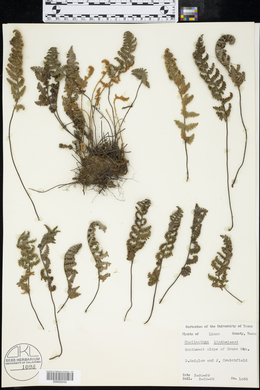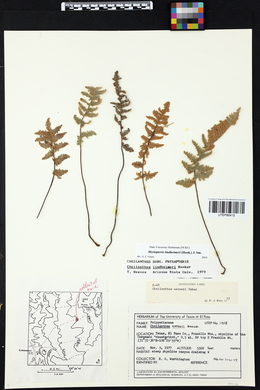Myriopteris lindheimeri
|
|
|
|
Family: Pteridaceae
Fairyswords, more...Lindheimer's lip fern, fairy swords, lindheimer lipfern, fairyswords (es: hierba de la peña)
[Cheilanthes lindheimeri Hook.] |
Stems long-creeping, 0.7--3 mm diam.; scales uniformly brown, ovate-lanceolate, straight to slightly contorted, loosely appressed, often deciduous on older portions of stem. Leaves scattered, 7--30 cm; vernation noncircinate. Petiole usually dark brown, rounded adaxially. Blade oblong-lanceolate to ovate-deltate, 4-pinnate at base, 2--5 cm wide; rachis rounded adaxially, with scattered linear-lanceolate scales and sparse monomorphic pubescence. Pinnae not articulate, dark color of stalk continuing into pinna base, basal pair not conspicuously larger than adjacent pair, usually equilateral, appearing densely tomentose adaxially. Costae green adaxially for most of length; abaxial scales multiseriate, lanceolate-ovate, truncate to cordate at base, usually without overlapping basal lobes, conspicuous, the largest 0.4--1 mm wide, strongly imbricate, often concealing ultimate segments, long-ciliate throughout, cilia fine, curly, forming entangled mass. Ultimate segments round to slightly oblong, beadlike, the largest 0.7--1 mm, abaxially nearly glabrous, often with a few small scales or branched hairs, adaxially appearing tomentose but actually nearly glabrous. False indusia marginal, weakly differentiated, 0.05--0.25 mm wide. Sori ± continuous around segment margins. Sporangia containing 32 spores. n = 2 n = 90, apogamous. Sporulating summer--fall. Rocky slopes and ledges; on a variety of acidic to mildly basic substrates; 200--2500 m; Ariz., N.Mex., Tex.; Mexico. Cheilanthes lindheimeri is an apogamous triploid of unknown parentage. It is occasionally misidentified as C . wootonii (actually the element here recognized as C . yavapensis ); most specimens can be placed using the characteristics given in the key. The adaxial blade surface appears to be densely gray tomentose, but this is an illusion created by the fine, curly cilia of the abaxial costal scales that overtop the minute ultimate segments and form an entangled mass that prevents the easy removal of individual costal scales.
General: Stems long creeping, 0.7-3 mm in diameter with uniformly brown scales, ovate-lanceolate, straight to slightly contorted, loosely appressed, often deciduous on older portions of stem. Leaves: Scattered, 7-30 cm, noncircinate vernation; petiole usually dark brown, rounded above; blade oblong-lanceolate to ovate-deltate, 4-pinnate at base, 2-5 cm wide; pinnae not articulate, dark color of stalk continuing into pinna base, basal pair not conspicuously larger than adjacent pair, appears densely tomentose above; costae green above for most of length; scales below multiseriate, lanceolate-ovate, cordate at base, overlapping basal lobes, strongly imbricate; long-ciliate throughout; cilia fine, curly, forming entangled mass; ultimate segments round to slightly oblong, beadlike, largest 0.7-1 mm, nearly glabrous below. Sporangia: False indusia marginal, weakly differentiated, 0.05-0.25 mm wide, sori more or less continuous around segment margins. Ecology: Found on rocky slopes and ledges, on a variety of acidic to mildly basic substrates from 1,000-8,500 ft (305-2591 m); sporulating summer-fall. Notes: Similar in appearance to C. wootonii and C. yavapensis. C. lindheimeri is distinguished by the appearance of densely tomentose upper surface of the pinnae, with pinnules less than 1 mm across, and cilia of the costal scales fine, curly and tangled. C. wootonii has a glabrous upper pinnae surface, with costal scalse ciliate only toward the base, and concolored rhizome scales. C. yavapensis has an upper pinnae surface that appears pubescent, due to the curly cilia of the costal scales, with the scales ciliate their entire length, and the same concolored rhizome scales. Etymology: Cheilanthes is from Greek cheilos for lip and anthos for flower, while lindheimeri is named for Ferdinand Jakob Lindheimer (1801-1879) a German naturalist who worked extensively in Texas as a botanical collector. Sources: FNA 1993, Yarborough and Powell 2002 FNA 1993, Yarborough and Powell 2002 Common Name: fairyswords General: Stems long creeping, 0.7-3 mm in diameter with uniformly brown scales, ovate-lanceolate, straight to slightly contorted, loosely appressed, often deciduous on older portions of stem. Leaves: Scattered, 7-30 cm, noncircinate vernation; petiole usually dark brown, rounded above; blade oblong-lanceolate to ovate-deltate, 4-pinnate at base, 2-5 cm wide; pinnae not articulate, dark color of stalk continuing into pinna base, basal pair not conspicuously larger than adjacent pair, appears densely tomentose above; costae green above for most of length; scales below multiseriate, lanceolate-ovate, cordate at base, overlapping basal lobes, strongly imbricate; long-ciliate throughout; cilia fine, curly, forming entangled mass; ultimate segments round to slightly oblong, beadlike, largest 0.7-1 mm, nearly glabrous below. Sporangia: False indusia marginal, weakly differentiated, 0.05-0.25 mm wide, sori more or less continuous around segment margins. Ecology: Found on rocky slopes and ledges, on a variety of acidic to mildly basic substrates from 1,000-8,500 ft (305-2591 m); sporulating summer-fall. Notes: Similar in appearance to C. wootonii and C. yavapensis. C. lindheimeri is distinguished by the appearance of densely tomentose upper surface of the pinnae, with pinnules less than 1 mm across; the central axis (costa) has scales with cilia throughout which are fine, curly and tangled. C. wootonii has a glabrous upper pinnae surface, with costal scalse ciliate only toward the base, and concolored rhizome scales. C. yavapensis has an upper pinnae surface that appears pubescent, due to the curly cilia of the costal scales, with the scales ciliate their entire length, and the same concolored rhizome scales. Ethnobotany: Unknown Etymology: Cheilanthes is from Greek cheilos for lip and anthos for flower, while lindheimeri is named for Ferdinand Jakob Lindheimer (1801-1879) a German naturalist who worked extensively in Texas as a botanical collector. Synonyms: None Editor: SBuckley 2010, FSCoburn 2015 |
|
|
|

































































































